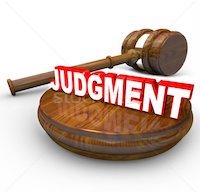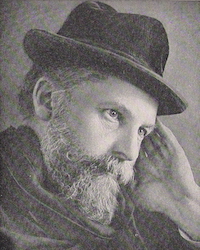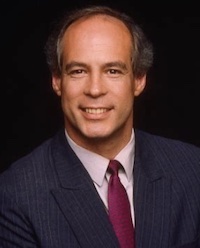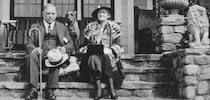|
|
|
 |
Judgment After Death
Posted on 22 November 2021, 9:19
If my evangelical and fundamentalist friends are right, I face a pretty harsh judgment after I die. My interest in the “demonic” things discussed in this blog and my books, as well as my failure to accept the “faith” and atonement doctrines, means I am headed straight into the fire and brimstone. Here’s how it might go, if they are correct. I will stand before God for my judgment. St. Peter will hand Him a scroll that covers my life history. God will review it and say:
“Ah, Michael, you sinner, I see here you willingly participated in the Seven Deadly Sins – pride, lust, envy, greed, sloth, wrath, and gluttony – along your journey, but you seem to have overcome them quite well, except perhaps for the last one. You could have presented yourself at least 20 pounds lighter. Overall, though, it appears that you led a reasonably disciplined and decent life, selfish at times, but giving more than taking. I commend you for your efforts in confronting the challenges I put before you.”
Me: “Thanks, God. I know I could have done better. It was that chocolate-peanut butter ice cream to which I so selfishly succumbed that led me astray, but I hope my gluttony was not really that bad and that you’ll let me pass through those pearly gates.”
At this point St. Paul stepped toward God and pointed to a particular part of the scroll, a part that seems to have escaped God’s attention. God’s eyes widened.
God: “It says here that you wrote a blog in which you denied Me. How could you?
Me: “Not really, God. That’s taken out of context. I was attempting to get the non-believers to look at the evidence for your kingdom and then discover You, rather than the other way around, which was much more difficult. So many of them pictured you as a very wrathful being who demands worship, like some Egyptian pharaoh. I was trying to suggest that they view it differently. I recalled the words of Jesus at Matthew 6:33, ‘Seek ye first the kingdom of God.’ I felt that if they discovered the kingdom by examining the evidence, they would then find You.”
God: “You idiot. Jesus was telling them to seek My kingdom before seeking material treasures. And why shouldn’t I be worshipped? You wouldn’t be here were it not for Me.”
Me: “Well, it seemed to me that you were beyond the need for worship?”
God: “I don’t like your attitude. I sentence you to eternal damnation.”
Me: “Oh, my God, the Bible thumpers were right?”
God: “You said it. Not Me.”
Me: “But I accepted most of the Bible in a metaphorical way. And Jesus has always been my role model, and I considered him the greatest prophet who ever lived and thought of him pretty much as chairman of the board in Your kingdom. Don’t I get any points for shouldering the burden rather than placing it all on him?”
God: “Sorry to say that you don’t. You should have listened to your friends.”
Me: “God, I gather I am going to have a lot of time to think about my mistakes, but just so I better understand, are you saying that I could have murdered, pillaged, blasphemed, and done all kinds of nasty things but would have been allowed entry to Your kingdom if I had repented and been ‘born again’ just before I died?”
God: “You’ve got it right there.”
Me: “And I could have been perfect in loving and serving my fellow man, but still not allowed entry simply because I didn’t worship properly? That doesn’t seem fair.”
God: “Who said anything about fairness? Didn’t your friends tell you that My ways are not always understood by man? And who are you to question my fairness, you disrespectful, arrogant, self-righteous, good-for-nothing, wicked, gluttonous philistine? I’ve got a few million more people here to judge today. Move on! Begone!”
The gavel slams down and I am suddenly like the bad guy in the movie, “Ghost,” in total torment as several howling, hellish spirits rush me, take hold, and carry me downward. All the while, my deceased friends, who had been looking on from the spectator seats, shake their heads and lament the fact that I did not heed their wise words concerning their interpretations of Scripture.

Modern Revelation
I refuse to believe in such a God or such a judgment. Modern revelation, coming to us primarily through mediumship and near-death experiences, offers us a much more sensible, rational, and fair judgment, if it can be called a “judgment,” one consistent with a loving and just God. Many near-death experiencers have reported a “life review” in which they see definitive moments in their life flash before them during the experience. P. M. H. Atwater, whose NDE took place during 1977, reported that she saw every thought she had ever had, every word she had ever spoken, and every deed she had ever done during her life review. Moreover, she saw the effects of every thought, word, and deed on everyone who might have been affected by them. As she interpreted it, she was judging herself.
Tom Sawyer, who had an NDE in 1978 when his car fell on him while he was working under it, recalled reliving every thought and attitude connected with decisive moments in his life and seeing them through the eyes of those who were affected by his actions. He particularly recalled an incident that took place when he was driving his hot-rod pickup at age 19 and nearly hit a jaywalking pedestrian, who darted in front of him from behind another vehicle. When Sawyer engaged in a verbal exchange with the pedestrian, the man yelled some four-letter words at him, reached through the window, and hit him with his open hand. Sawyer responded by jumping out of his car and beating the man relentlessly. During his life review, Sawyer came to know everything about the man, including his age, the fact that his wife had recently died, and that he was in a drunken state because of his bereavement.
“[I experienced] seeing Tom Sawyer’s fist come directly into my face,” he recalled. “And I felt the indignation, the rage, the embarrassment, the frustration, the physical pain…I felt my teeth going through my lower lip – in other words, I was in that man’s eyes. I was in that man’s body. I experienced everything of that inter-relationship between Tom Sawyer and that man that day. I experienced unbelievable things about that man that are of a very personal, confidential, and private nature.”
Although he does not refer to it as a life review, Carl Gustav Jung, the eminent Swiss psychiatrist, writes of something very similar in describing a near-death experience he had in 1944 after breaking his foot and then having a heart attack. “It was as if I now carried along with me everything I had ever experienced or done, everything that had happened around me. I might also say: it was with me, and I was it. I consisted of all that, so to speak. I consisted of my own history, and I felt with great certainty: this is what I am. ‘I am this bundle of what has been, and what has been accomplished.’” Jung went on to say that he had the certainty that he was about to enter an illuminated room and then understand the historical nexus of his life and what would come after. However, his vision ceased before he had such an experience.
Moral Specific Gravity
As Robert Hare, emeritus professor of chemistry at the University of Pennsylvania, came to understand it from several years of communicating with the spirit world, one’s immediate place in the afterlife “is determined by a sort of moral specific gravity, in which merit is measured inversely as weight.”
This “moral specific gravity” is apparently built up during a person’s lifetime based on his or her good or works or lack thereof and manifests itself in the person’s energy field, or aura. Hare called it a circumambient halo and was told that it passes from darkness to effulgence based on the degree of spirit advancement. Moreover, one cannot be dishonest with himself as the moral specific gravity allows him to tolerate only so much light. If he were to try to cheat and go to a higher sphere, he would not be able to tolerate the light there.
After his death, pioneering psychical researcher Frederic W. H. Myers (below) communicated extensively through the mediumship of Geraldine Cummins of Ireland. Myers referred to the period immediately after death as Hades and “The Play of the Shadow Show.” He said that this period varies considerably from individual to individual, but generally after the soul is greeted by deceased loved ones it experiences a semi-suspended consciousness and sees fragmentary happenings of the life just lived.

“He watches this changing show as a man drowsily watches a shimmering sunny landscape on a midsummer day,” Myers explained. “He is detached and apart, judging the individual who participates in these experiences, judging his own self with aid of the Light from Above.
Myers further explained that while this is taking place, the etheric body is loosening itself from the “husk” and when the judgment is completed, generally after three to four days, the soul takes flight, passes into the world of illusion, and resumes full consciousness.
The Rev. William Stainton Moses, an Anglican priest, developed into a medium and put many questions to an apparently advanced spirit called Imperator. One of the questions he asked was whether there is a general judgment. “No,” was the response. “The judgment is complete when the spirit gravitates to the home which it has made for itself. There can be no error. It is placed by the eternal law of fitness. That judgment is complete, until the spirit is fitted to pass to a higher sphere, when the same process is repeated, and so on and on until the purgatorial spheres of work are done with, and the soul passes within the inner heaven of contemplation.”
Imperator explained to Moses that the soul is the arbiter of its own destiny and that the “sentence” it imposes upon itself is based on the character it has built up by its earthly acts.
Seemingly consistent with the moral specific gravity idea is the explanation given to Frederick C. Schulthorp during his early 20th Century astral projections. Schulthorp was told that every thought generates an electrical impulse that is impressed upon the individual’s energy field and is stored there. Every thought, he was informed by communicating spirits, has a specific rate of vibration. The combined vibrations over a lifetime determine the person’s initial station in the afterlife environment. “Upon entry into spirit life, a person will naturally and automatically gravitate to his state in spirit which corresponds to his acts and thoughts throughout life as reproduced by his ‘personal tape record,’” Schulthorp explained his understanding at a time before computers made this comprehensible to the average person.
A moral specific gravity is an idea that appeals to reason and one that can be reconciled with a just and loving God. It is a plan of attainment and attunement, of gradual spiritual growth, of reaping what we sow.
Michael Tymn is the author of The Afterlife Revealed: What Happens After We Die, Resurrecting Leonora Piper: How Science Discovered the Afterlife, and Dead Men Talking: Afterlife Communication from World War I.
His latest book, No One Really Dies: 25 Reasons to Believe in an Afterlife is published by White Crow books.
Next blog post: Dec. 6
Read comments or post one of your own
|
 |
Aerospace Magnate Robert Bigelow Searches for Answers on Life After Death
Posted on 08 November 2021, 8:34
When Robert T. Bigelow, (below) the founder of Bigelow Aerospace in Las Vegas, Nevada, announced in January that he was launching the Bigelow Institute for Consciousness Studies (BICS) and sponsoring an essay competition on the best evidence for life after death, I had doubts about the success of such a contest. It seemed to me the best evidence had already been discussed and reported by various researchers and by people experiencing paranormal events, such as near-death experiences, and I questioned whether anyone would be able to come up with fresh ideas on the subject. I speculated that only a half-dozen people would enter the contest. As it turned out, however, more than 1,200 applied and 200 of those were selected to submit essays.

The winners were announced on November 1, first prize of $500,000 going to Jeffrey Mishlove, Ph.D., (below) an American clinical psychologist, second prize of $300,000 to Pim Van Lommel, M.D., a Dutch cardiologist, and third prize of $150,000 to Leo Ruickbie, Ph.D., a sociologist and editor for the Society for Psychical Research in England. I was fortunate to win a runner-up prize of $50,000 for my essay titled, “Long Concealed – Now Revealed” in which I argued that the best and most overwhelming evidence was produced and documented before 1920. Much evidence has been produced since 1920, but it is “icing on the cake” – a cake that was baked between 1850 and 1920.

The essays will be officially posted at the Bigelow Institute website within the next week or two. Although I have not had the opportunity to read Mishlove’s winning entry, I gather that he cited both current and past evidence in his essay, offering it in a way that should make sense to the average layperson, not just to those with an academic mindset. Of course, those subscribing to a philosophy of nihilism will turn up their noses at it, but those with open minds should find much meaningful evidence to ponder on, not only in Mishlove’s essay but in all those posted.
As I am not a researcher, academician, psychologist, parapsychologist, or doctor of any kind, I didn’t feel qualified to enter the contest, but I did consider the fact that, from some 25 years of study, I have become a historian of sorts on the early psychical research. So few people I have met know anything about that research. I’ve talked with or interviewed a number of modern-day researchers and even they seem to know little about the pre-1920 research. The late Carlos Alvarado, Ph.D., was probably the foremost authority on the subject and Stafford Betty, Ph.D., a retired religion and philosophy professor, is another person very familiar with the subject matter, but I think I can count on one hand the number of people I have met who have really explored the research of the pioneers – men like Judge John Edmonds, Dr. George Dexter, Professor Robert Hare, biologist Alfred Russel Wallace, Sir William Barrett, Sir William Crookes, Sir Oliver Lodge, Dr. Richard Hodgson, Professor James Hyslop and others.
As I see it, the case for survival was made by those pioneers before 1920, but because religion had been impeached by science, especially Darwinism, and because most scientists saw psychical research as having the same objectives as religion, the research carried out by those pioneers was ignored or rejected as just so much bunk. Moreover, religions rejected it because some of it conflicted with established dogma and doctrine. Thus, they saw it as “demonic.”
As suggested in my paper, the evidence strongly lending itself to proof that consciousness survives bodily death in a larger reality is substantial; it is nonetheless, complex, confusing, convoluted, complicated and sometimes conflicting, seemingly beyond the limits of exact or pure science. It can, however, be examined from the standpoint of more inexact science; that is, courtroom science. The objective is not absolute certainty. It is conviction – a degree of certainty that provides much more peace of mind than the blind faith of religions.
Based on what several of the pioneers were told by communicating spirits, they were experimenting on their side in their attempts to communicate with us. The discarnate Benjamin Franklin, with the assistance of Emanuel Swedenborg, the great Swedish polymath of the eighteenth century, figured out how to communicate with the material world by means of raps, taps, and table turning. It gradually progressed from there to include the trance voice, the direct voice, automatic writing, materializations, and other phenomena. However, the obstacles to clear communication were many, including the need to overcome distortions by the medium’s mind. Much of the communication involved thought-transference – the spirit communicator projecting an idea with some symbolism, which was then misinterpreted by the medium’s mind and resulted in incorrect information. Such inaccuracies brought forth cries of fraud from the debunkers.
Edmonds, who served as Chief Justice of the New York Supreme Court, was told by a spirit communicator that there was much opposition in the spirit world to communication between realms. He added that “a combination has been formed to interrupt and, if possible, to overthrow it, and one mode is by visiting circles and individuals, exciting their suspicions of spirits, and bad thoughts as to their good faith and purity of purpose.”
Skeptics often ask why there was so much more dynamic mediumship 100-170 years ago than there is now. My take on that is that is that people of that time needed it more than we do and the conditions were better. They had fewer escapes than we do – no radio, television, computers, phones, etc. Their church was their primary retreat in times of grief and mourning, but Darwinism had impeached religion and they had no sanctuary or any other haven for escape. The nihilism of materialism resulted in a doom and gloom mindset and a very melancholy approach to life, all at a time when hardships were abundant for most people, and when the greater part of the population was struggling to make a living, to simply survive. When the fundamentalists of science pulled the rug out from under them and told them that this life is all there is, they lost hope.
Seeing such a condition in the material world, some in the spirit world felt that they had to make their presence known in order to assuage the hopelessness and despair. Others, however, felt that the added adversity offered greater opportunities to learn and advance, and therefore they opposed it. There may have been “earthbound” spirits who opposed it because they were still clinging to their earthly religious teachings.
At some point, around 1900, the so-called Spiritualist movement was in decline, primarily because the waters had been muddied by the charlatans and the fundamentalists of science, thereby casting doubt on the genuine mediums. On top of that, the genuine mediums were not infallible and when wrong information came through or when conditions were so inharmonious that they could not produce phenomena at all, they also were written off as frauds. William Stainton Moses, an Anglican priest who became a gifted medium, was told by spirits that they overestimated their ability to help out, not anticipating so much abuse and ignorance on our side. Thus, they withdrew.
The Great War resulted in a resurgence of spirit communication, but the “Roaring Twenties” that followed the war saw a return to more materialistic ways, extending to hedonism and epicureanism, and a rapid decline in the more dynamic forms of mediumship. When radio, movies, and then television came into the world, people no longer had to sit around their fireplaces knitting or whittling in a somewhat meditative state as they stared into the fire. The “noise” from their electronic gadgets prevented contact from the spirit world and the spirit world gradually gave up.
The turning point was the death of Hyslop in 1920. A professor of logic and ethics at Columbia University before becoming a full-time researcher, Hyslop promoted the evidence for “survival” more than any other person. Seeing the disparagement of Hyslop by those stuck in the muck and mire of materialistic science, other researchers were reluctant to step up and take his place.
The field of parapsychology replaced psychical research during the 1930s, avoiding mediums, any mention of spirits of the dead, or of life after death. Such mention would have discouraged funding and invited scoffs and sneers from the more “intellectual” academicians and scientists. If science couldn’t explain the psychic phenomena, then it was left for science to figure it out in the future without invoking something as “ridiculous” as spirits of the dead.
Meanwhile, Hollywood and Madison Avenue continued to promote hedonism, epicureanism, and nihilism. Research in past-life memories, near-death experiences, clairvoyance and other paranormal phenomena resulted in a few best-sellers and influenced some people who had abandoned orthodox religion to adopt a more spiritual philosophy, but the predominant worldview continued to be one of nihilism, which means “lights out” when we die.
“It is probably time to end this closed-minded approach,” the introduction to the Bigelow Institute for Consciousness Studies website reads, going on to state that “One purpose of the BICS is to raise awareness among the public and within the scientific community of the importance and relevance of such [research]. BICS hopes to provide a public service by drawing increasing attention to, and encouraging research into, this fundamental and timeless topic…”
Hopefully, such interest in the “survival” issue by Bigelow and other prime movers will help the world reverse directions and see a bigger picture within a larger life.
Michael Tymn is the author of The Afterlife Revealed: What Happens After We Die, Resurrecting Leonora Piper: How Science Discovered the Afterlife, and Dead Men Talking: Afterlife Communication from World War I.
His latest book, No One Really Dies: 25 Reasons to Believe in an Afterlife is published by White Crow books.
Next blog post: November 22
Read comments or post one of your own
|
|
|
 |
 |
 |
 |
 |
|
|
 |
 |
 |
 |
 |
| Mackenzie King, London Mediums, Richard Wagner, and Adolf Hitler by Anton Wagner, PhD. – Besides Etta Wriedt in Detroit and Helen Lambert, Eileen Garrett and the Carringtons in New York, London was the major nucleus for King’s “psychic friends.” In his letter to Lambert describing his 1936 European tour, he informed her that “When in London, I met many friends of yours: Miss Lind af Hageby, [the author and psychic researcher] Stanley De Brath, and many others. Read here |
|